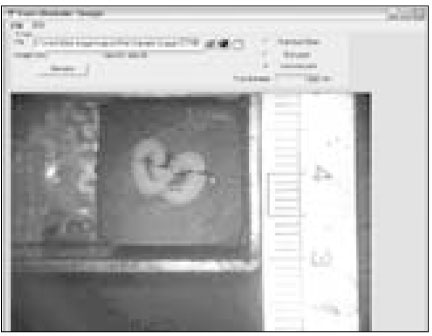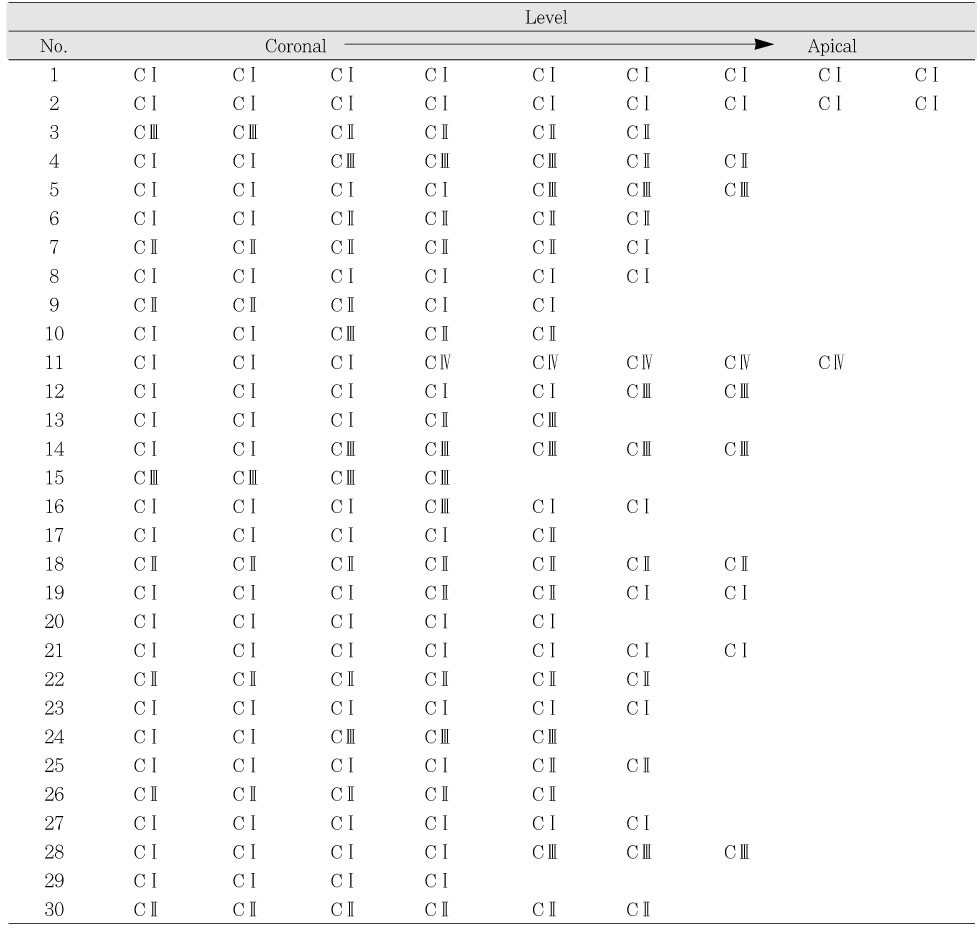Articles
- Page Path
- HOME > Restor Dent Endod > Volume 32(1); 2007 > Article
- Original Article Cross-sectional morphology and minimum canal wall widths in C-shaped root of mandibular molars
- Byung-Chul Song, Yong-Bum Cho
-
2007;32(1):-46.
DOI: https://doi.org/10.5395/JKACD.2007.32.1.037
Published online: January 31, 2007
Department of Conservative Dentistry, College of Dentistry, Dankook University, Korea.
- Corresponding Author: Yong-Bum Cho. Department of Conservative Dentistry, College of Dentistry, Dankook University, 7-1 Shinbu-dong, Cheonan, Korea. Tel: 82-41-550-1966, Fax: 82-41-550-1963, raindrop@dku.edu
• Received: January 23, 2007 • Revised: January 25, 2007 • Accepted: January 27, 2007
Copyright © 2007 Korean Academy of Conservative Dentistry
- 667 Views
- 1 Download
Abstract
-
The C-shaped canal system is an anatomical variation mostly seen in mandibular second molars, although it can also occur in maxillary and other mandibular molars. The main anatomical feature of C-shaped canals is the presence of fins or web connecting the individual root canals. The complexity of C-shaped canals prevents these canals from being cleaned, shaped, and obturated effectively during root canal therapy, and sometimes it leads to an iatrogenic perforation from the extravagant preparation.The purpose of this study was to provide further knowledge of the anatomical configuration and the minimal thickness of dentinal wall according to the level of the root.Thirty extracted mandibular second molars with fused roots and longitudinal grooves on lingual or buccal surface of the root were collected from a native Korean population. The photo images and radiographs from buccal, lingual, apical direction were taken. After access cavity was prepared, teeth were placed in 5.25% sodium hypochlorite solution for 2 hours to dissolve the organic tissue of the root surface and from the root canal system. After bench dried and all the teeth were embedded in a self-curing resin. Each block was sectioned using a microtome (Accutom-50, Struers, Denmark) at interval of 1 mm. The sectioned surface photograph was taken using a digital camera (Coolpix 995, Nikon, Japan) connected to the microscope. 197 images were evaluated for canal configurations and the minimal thickness of dentinal wall between canal and external wall using' Root Thickness Gauge Program' designed with Visual Basic.The results were as follows:1. At the orifice level of all teeth, the most frequent observed configuration was Melton's Type C I (73%), however the patterns were changed to type C II and C III when the sections were observed at the apical third. On the other hand, the type C III was observed at the orifice level of only 2 teeth but this type could be seen at apical region of the rest of the teeth.2. The C-shaped canal showed continuous and semi-colon shape at the orifice level, but at the apical portion of the canal there was high possibility of having 2 or 3 canals.3. Lingual wall was thinner than buccal wall at coronal, middle, apical thirds of root but there was no statistical differences.
- 1. Rice RT, Gilbert BO. An unusual canal configuration in a mandibular first molar. J Endod. 1987;13(10):515-519.ArticlePubMed
- 2. Manning SA. Root canal anatomy of mandibular second molars. Part 2 C-shaped canals. Int Endod J. 1990;23(1):40-45.PubMed
- 3. Haddad GY, Nehme WB, Ounsi HF. Diagnosis, classification, and frequency of C-shaped canals in Mandibular second molars in the Lebanese population. J Endod. 1999;25(4):268-271.ArticlePubMed
- 4. Weine FS, Pasiewicz RA, Rice RT. Canal configuration of the mandibular second molar using a clinically oriented in vitro method. J Endod. 1988;14(5):207-213.ArticlePubMed
- 5. Weine FS, Healey HJ, Gerstein H, Evanson L. Canal configuration in the mesiobuccal root of maxillary first molar and its endodontic significance. Oral Surg Oral Med Oral Pathol. 1969;28(3):419-425.PubMed
- 6. Seidberg BH, Altman M, Guttuso J, Surson M. Frequency of two mesiobuccal root canals in maxillary permanent first molars. J Am Dent Assoc. 1973;87(4):852-856.ArticlePubMed
- 7. Sidow SJ, West Liewehr FR, Loushine RJ. Root canal morphology of human maxillary and mandibular third molars. J Endod. 2000;26(11):675-678.ArticlePubMed
- 8. Hess W, Zeushcer E. The anatomy of the root canals of the teeth of permanent dentition. 1925;London: John Bale, Sons and Danielsson; 32-34.
- 9. Melton DC, Krell KV, Fuller MW. Anatomical and histological features of C-shaped canals in mandibular second molars. J Endod. 1991;17(8):384-388.ArticlePubMed
- 10. Lyroudia K, Nikolaidis N, Pitas I, Zervas P, Palakidis K. Computerized three-dimensional reconstruction: a method to study pulpal vessels and nerves. J Endod. 1993;19(12):604-608.PubMed
- 11. Cimilli H, Cimilli T, Mumcu G, Katal N, Wesselink P. Spiral computed tomographic demonstration of C-shaped canals in mandibular second molars. Dentomaxillofac Radiol. 2005;34(3):164-167.ArticlePubMed
- 12. Weine FS. The C-shaped mandibular second molar: incidence and other considerations. Members of the Arizona Endodontic Association. J Endod. 1998;24(5):372-375.PubMed
- 13. Seo MS, Park DS. C-shaped root canals of mandibular second molars in a Korean population: clinical observation and in vitro analysis. Int Endod J. 2004;37(2):139-144.ArticlePubMed
- 14. Cooke HG 3rd, Cox Fl. C-shaped canal configurations in mandibular molars. J Am Dent Assoc. 1979;99(5):836-839.PubMed
- 15. Bolger WL, Schinndler WG. A mandibular first molar with a C-shaped root configuration. J Endod. 1988;14(10):515-519.ArticlePubMed
- 16. Dankner E, Friedman S, Stabholz A. Bilateral C-shape configuration in maxillary first molars. J Endod. 1990;16(12):601-603.ArticlePubMed
- 17. Blasković-Subat V, Smojver B, Maricic B, Sutalo J. A computerized method for the evaluation of root canal morphology. Int Endod J. 1995;28(6):290-296.ArticlePubMed
- 18. Vertucci FJ. Root canal anatomy of human permanent teeth. Oral Surg Oral Med Oral Pathol. 1984;58(5):589-599.PubMed
- 19. Sidow SJ, West LA, Liewher FR, Loushine RJ. Root canal morphology of humal maxillary and mandibular third molar. J Endod. 2000;26(11):675-678.PubMed
- 20. Yang ZP, Yang SF, Lin YC, Chi CY. C-shaped root canals in mandibular second molars in a chinese population. Endod Dent Traumatol. 1988;4(4):160-163.ArticlePubMed
- 21. Melton DC, Krell KV, Fuller MW. Anatomical and histological features of C-shaped canals in mandibular second molars. J Endod. 1991;17(8):384-388.ArticlePubMed
- 22. Abou-Rass M, Frank AL, Glick DH. The anticurvature filing method to prepare the curved root canal. J Am Dent Assoc. 1980;101(5):792-794.ArticlePubMed
- 23. Liewehr FR, Kulild JC, Primack PD. Obturation of a C-shaped canal using an improved method of warm lateral condensation. J Endod. 1993;19(9):474-477.ArticlePubMed
- 24. Weine FS. Endodontic therapy on the mandibular second molar: easiest to treat of the difficult, molar teeth. Compendium. 1994;15(9):1130.PubMed
- 25. Walid N. The use of two pluggers for the obturation of an uncommon C-shaped canal. J Endod. 2000;26(7):422-424.ArticlePubMed
- 26. Marshak BL, Helft H, Filo R. Factors mitigating against the use of dowels in endodontically treated teeth. Quintessence Int. 1988;19(6):417-421.PubMed
- 27. Manning SA. Root canal anatomy of mandibular second molars. Part 1 .C-shaped canals. Int Endod J. 1990;23(1):34-39.PubMed
REFERENCES
Tables & Figures
REFERENCES
Citations
Citations to this article as recorded by 

Cross-sectional morphology and minimum canal wall widths in C-shaped root of mandibular molars



Figure 1
Classification of the canal configuration.
Figure 2
Computer program, measuring minimum wall thickness.
Figure 3
The transfiguration of the canal.
Figure 1
Figure 2
Figure 3
Cross-sectional morphology and minimum canal wall widths in C-shaped root of mandibular molars
The transfiguration of canals at different levels
Number of specific canal type at different levels
Tooth without any change of configuration
Minimum wall thickness at buccal side (mm)
Minimum wall thickness at lingual side (mm)
Table 1
The transfiguration of canals at different levels
Table 2
Number of specific canal type at different levels
Table 3
Tooth without any change of configuration
Table 4
Minimum wall thickness at buccal side (mm)
Table 5
Minimum wall thickness at lingual side (mm)

 KACD
KACD








 ePub Link
ePub Link Cite
Cite

